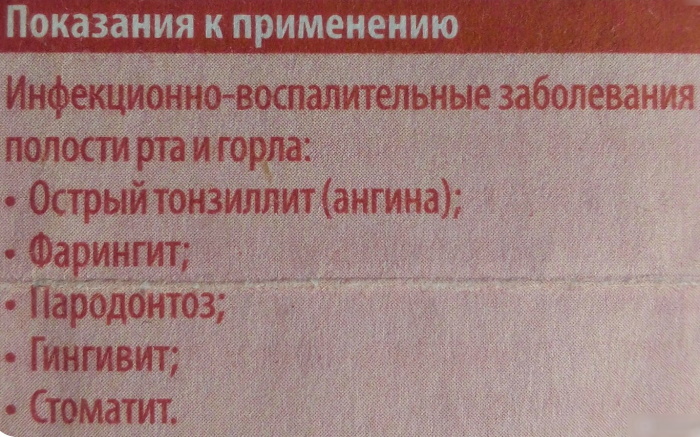Content
- Causes of epigastric pain radiating to the back
- Stomach ulcer
- Perforated ulcer
- Acute pancreatitis
- Hepatic colic
- Pyloric stenosis
- Gastritis
- Cholecystitis
- Hernia
- Intestinal infection
- Neoplasms
- Respiratory damage
- Myocardial infarction
- Intercostal neuralgia
- Differentiation of causes
- Diagnostic methods
- Treatment
- Help before diagnosis
- Conservative therapy
- Surgery
- Videos about epigastric pain
Pain in the stomach (epigastric region) gives to the back for various acute and chronic diseases. The clinical syndrome sometimes causes discomfort to a person, interfering with normal sleep and eating. The treatment regimen should be selected individually, depending on the age and condition of the patient.
Causes of epigastric pain radiating to the back
Epigastric pain radiates to the back for various reasons. Often, discomfort occurs with physical strain or after eating.
Pain can be:
- bursting;
- stupid;
- sharp;
- weak;
- cutting.

Epigastric pain
The severity of the clinical syndrome can also vary. Back pain is usually intermittent. The syndrome can be accompanied by diarrhea, temperature fluctuations, coughing and bouts of nausea.
Stomach ulcer
Stomach ulcer refers to chronic recurrent pathologies. The disease is characterized by the appearance of small ulcers on the surface of the mucous walls.
Most often, pathology develops against the background:
- stressful situations;
- long-term intake of medications that have a gastrotoxic effect;
- hyperparathyroidism.
In addition to acute pain radiating to the back, patients with stomach ulcers often complain of:
- vomiting;
- increased gas formation;
- heartburn.
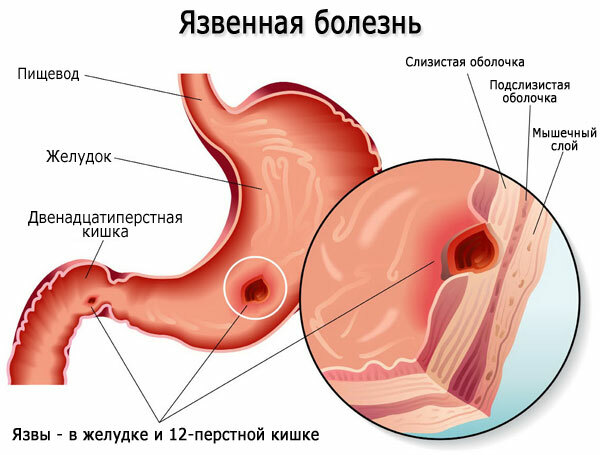
Patients sometimes refuse food. The pain subsides slightly after the person induces vomiting. Pathology, in the absence of adequate treatment, can provoke a number of complications, the most severe of which is perforation of the gastric wall. A through hole is formed on it, through which the contents of the stomach penetrate into the abdominal cavity. The condition is often accompanied by internal bleeding.
Perforated ulcer
With a perforated ulcer on the surface of the gastric wall, a through hole is used. Often, pathology is formed in the elderly.
Diseases develop against the background:
- chronic or acute gastric ulcer;
- respiratory disorders;
- circulatory disorders;
- atherosclerosis;
- dysfunction of the endocrine glands.
There are several main stages in the course of a perforated ulcer. The most difficult is the third. The period of exacerbation is 12 or more hours. The pathology is characterized by interintestinal abscess and purulent-type peritonitis. The main symptom indicating the development of a perforated ulcer is acute, persistent pain in the epigastric region. Also, patients complain of shortness of breath, bradycardia and surges in blood pressure.
Acute pancreatitis
In acute pancreatitis, the pancreas becomes inflamed. The pain usually radiates to the area of the scapula or hypochondrium.

The disease is characterized by:
- yellowness of the sclera;
- jumps in body temperature;
- vomiting;
- bouts of nausea.
The pain usually worsens after eating. The clinical syndrome manifests itself constantly, especially if a person spends a lot of time lying down.
The accompanying signs of acute pancreatitis include:
- heartburn;
- flatulence;
- the appearance of blue spots on the skin.
Most often, the disease is caused by:
- accumulation of pus in the tissues of the pancreas;
- false cysts;
- purulent pancreatitis;
- gallstone disease.
Acute pancreatitis is often diagnosed in people who systematically abuse spicy, fatty foods and alcoholic beverages.
Hepatic colic
Hepatic colic is not a disease, but a clinical syndrome that manifests itself as an attack of acute visceral pain. Its development may indicate cholelithiasis or cholecystitis. Hepatic colic is usually caused by the systematic abuse of alcohol and fatty foods. It is also diagnosed in pregnant women and people arriving in a prolonged stressful situation.
The pain usually radiates under the scapula or in the right hypochondrium. It has a tearing, stabbing and cutting character. Most often, the attack occurs at night. With hepatic colic, patients also complain of bloating, uncontrolled vomiting of bile, and bouts of nausea. The pain is quite intense. It is usually caused by a distension of the gallbladder with stones. An attack of hepatic colic lasts 15-360 minutes. Concomitant symptoms include temperature jumps, yellowing of the skin, fever.
Pyloric stenosis
With pyloric stenosis, there is a narrowing of the outlet lumen of the stomach. Usually, the disease is provoked by ulcerative lesions, tumors of a benign and malignant nature. With an ulcer, the inflammatory process provokes spasms and edema of the walls. Scars form on them, the passage of food into the small intestine slows down. In addition to acute pain, patients complain of uncontrolled vomiting after each meal.
Also, signs of pyloric stenosis include heartburn, belching, heaviness in the stomach, diarrhea, stomach cramps, dry mucous membranes and skin, splash noise. With pyloric stenosis, violations of the motor-evacuation function of the stomach are observed.
Gastritis
Gastritis is a chronic or acute disease, accompanied by inflammation of the gastric mucosa. The pathology is quite common, it is diagnosed in 80% of patients over 30 years old.
The main reasons for the development of gastritis include:
- reproduction of the bacteria Helicobacter Pylori, which provoke inflammation;
- penetration into the stomach of substances that have a toxic effect (acids, salts of heavy metals, alkalis, ethyl alcohol);
- prolonged stay in stressful situations;
- eating disorder (systematic abuse of spicy, fatty, acidic foods).
Also, gastritis can cause various pathologies of the digestive tract (for example, reflux gastritis, duodenitis).
In addition to acute pain that radiates to the scapula and back, patients complain of:
- belching;
- heartburn;
- nausea;
- flatulence;
- diarrhea;
- dizziness;
- runny nose;
- chills;
- fever.
People with gastritis experience weight loss caused by impaired absorption and digestion of food.
Cholecystitis
Cholecystitis is a pathology of the gallbladder caused by an inflammatory process. The disease is characterized by tonic-motor dysfunction of the gallbladder. Most often, pathology is diagnosed in people over 45 years old.
At risk are people suffering from:
- dyscholia;
- hormonal disorders (especially during menopause and pregnancy);
- hypodynamia.
Also, cholecystitis is often diagnosed in people who abuse tobacco products, alcoholic beverages and fatty, spicy foods.
In addition to acute pain, the following symptoms may indicate the development of cholecystitis:
- nausea;
- diarrhea or constipation;
- heaviness in the stomach and right hypochondrium;
- hypotension;
- dyspnea;
- tachycardia;
- bitter belching;
- bitterness in the mouth;
- chills;
- bouts of nausea.
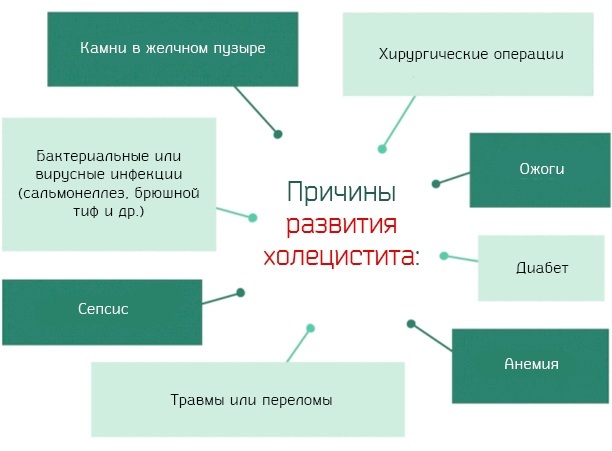
The pain intensifies against the background of physical overwork, stress and non-observance of the basic principles of proper nutrition.
Hernia
A hernia of the opening of the diaphragm is accompanied by the formation of a protrusion, which is formed against the background of the displacement of the anatomical structures into the chest cavity.
Pathology usually develops against the background:
- cough with obstructive bronchitis;
- severe obesity;
- mechanical injuries of the peritoneum;
- sharp slopes;
- lifting weights;
- flatulence;
- incessant vomiting;
- chronic constipation.
The characteristic symptoms of the disease include:
- dysphagia;
- tachycardia;
- nausea;
- vomiting with blood impurities;
- hypotension;
- tachycardia;
- shortness of breath;
- cyanosis;
- pain radiating to the back;
- hiccups;
- heartburn;
- hoarseness.
During sleep, there is a high risk of developing regurgitation.
Intestinal infection
A number of viral and bacterial pathologies of infectious etiology can be attributed to intestinal infections.
The following microorganisms act as pathogens:
- clostridia;
- klebsiella;
- Yersinia;
- salmonella;
- shigella;
- escherichia;
- campylobacter.
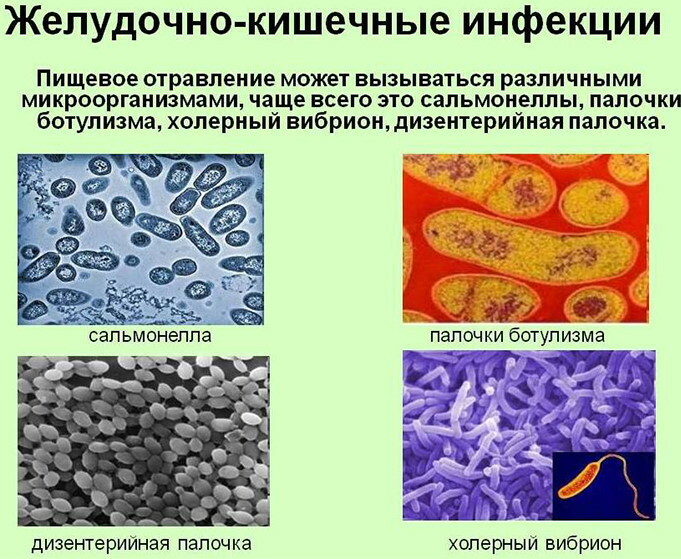
Also, intestinal infection can be triggered by adenovirus, enterovirus and rotavirus. Most often, infection occurs by contact-household, water, alimentary methods.
Typical symptoms of intestinal infections include:
- vomiting;
- lack of appetite;
- mild convulsions;
- pain in the epigastric region;
- diarrhea with blood or mucus.
Often, patients complain of dry mucous membranes and skin, bradycardia, tachycardia.
Neoplasms
Stomach cancer is characterized by metastasis to the small intestine and pancreas. Scientists have not identified the exact reasons for the development of pathology.
At risk are people suffering from:
- chronic gastric ulcer;
- atrophic gastritis;
- chronic gastritis;
- gastric adenoma.
In people who do not follow the diet and systematically abuse alcohol, tobacco products are diagnosed more often with cancer.
Typical symptoms indicating the growth of malignant neoplasms include:
- dysphagia;
- weight loss;
- lack of appetite;
- heaviness and pain in the stomach;
- weakness;
- rapid fatigue.
If the tumor has grown into the blood vessels, then there is a high risk of developing internal bleeding.
Respiratory damage
Pain in the epigastric region may indicate the development of respiratory diseases.
These include:
- obstruction of the lungs;
- pneumonia;

- bronchitis;
- laryngitis;
- pharyngitis;
- tonsillitis;
- sinusitis;
- rhinitis;
- ARVI.
Concomitant symptoms include loss of smell, ear and nose congestion, headache, and sputum production.
Myocardial infarction
Myocardial infarction is an acute form of ischemic heart disease.
At risk are people suffering from:
- arterial hypertension;
- obesity;
- diabetes mellitus.
The development of a heart attack can provoke malnutrition, alcohol and tobacco abuse.
Symptoms of myocardial infarction include:
- pain in the epigastric region;
- nausea;
- chest pain;
- increased heart rate;
- asthma attacks;
- cold sweat;
- dizziness.
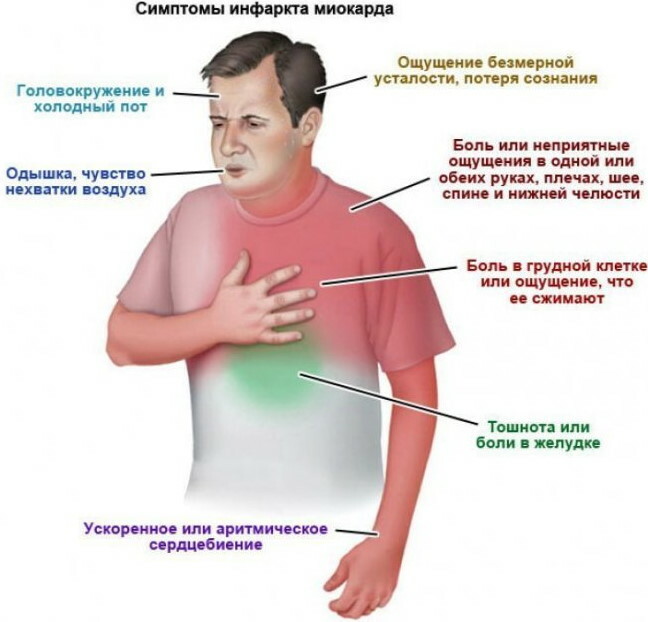
The skin turns blue during a heart attack. Cyanosis spreads to the ears, nose, and lips.
Intercostal neuralgia
Intercostal neuralgia is a clinical syndrome characterized by nerve damage. Burning, paroxysmal pain occurs in the epigastrium and sternum.
The main reasons for the development of the syndrome are considered:
- chondrosarcoma;
- lipoma;
- osteoma;
- chondroma;
- intervertebral hernia;
- osteochondrosis;
- spondylosis;
- mechanical injury.
Symptom complex indicating the development of intercostal neuralgia:
- acute pain in the epigastric region, spasm during inhalation and exhalation;
- paresthesia;
- hyperemia;
- hyperhidrosis.
Pain with intercostal neuralgia is usually sharp and paroxysmal.
Differentiation of causes
Pain in the epigastrium gives back to the back, often with intestinal infections.

To make an accurate diagnosis, a specialist must differentiate the cause of the development of pathology:
| Determining factor | Type of pain, time of onset, accompanying symptoms | Pathology |
| Spasm type | Pain in the navel area | Appendicitis |
| Intense spasm | Colon diseases | |
| Cramping pain | Intestinal, gastric infections | |
| Aching, weak pain | Polyps, malignant tumors | |
| Short-term pain | Violation of the systemic circulation, spasms of the diaphragm | |
| Acute cramping pain | Inflammation, ulceration of the duodenum and stomach | |
| Aching dull pain | Gastritis, ulcer | |
| Sharp severe pain | Ulcerative perforation | |
| Sharp sudden pain | Chemical burn, poisoning | |
| Sharp pain | Ulcer, cholecystitis, pancreatitis | |
| The presence of food in the stomach | Eating in the evening and lunchtime | Irritable bowel syndrome, GDD, celiac disease, acute gastroenteritis, lactose intolerance |
| The presence of accompanying symptoms | Heartburn, belching, bitter taste, nausea, vomiting | Acidity, pancreatitis, gastroduodenitis, esophagitis, gastroesophageal reflux disease, stomach flu |
Diagnostics includes several methods (laboratory tests, diagnostic measures).
Diagnostic methods
Pain in the epigastrium radiates to the back with an ulcer of the perforated type. Diagnostic measures include a number of laboratory and instrumental studies. To make an accurate diagnosis, the doctor carefully examines the patient, listening to his complaints. The epigastric region is palpated to determine the nature and localization of pain. The doctor should take a history. The patient tells the specialist in detail what medications he took, what food he ate.
After questioning and examination, the doctor prescribes:
- CT;
- MRI;
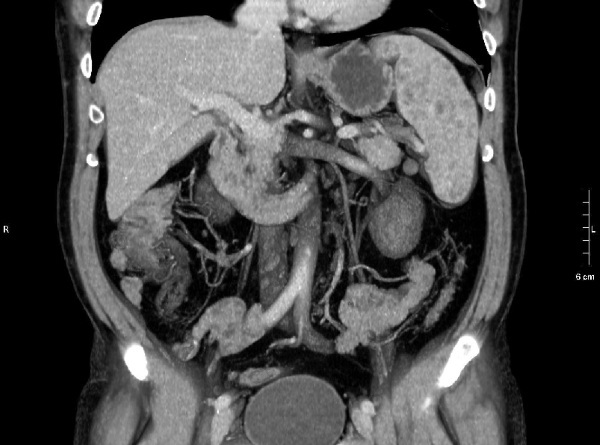
- Ultrasound;
- sounding.
Also, the patient must pass an analysis of feces, urine and blood. Microscopy is also done if necessary. During probing, part of the stomach contents is taken for analysis. This procedure allows you to determine the acidity. On ultrasound, the doctor determines the condition of the walls of the organ. With the help of MRI and CT, stomach cancer is diagnosed.
Treatment
Pain in the epigastric region after eating requires immediate treatment. She can kick in the back for a number of reasons. Treatment of pathologies of the digestive tract organs should be comprehensive. The doctor prescribes medications for patients and selects a diet on an individual basis.
Help before diagnosis
If an attack of pain occurs suddenly, then you need to lie down as soon as possible. Drugs should not be taken without a doctor's prescription. Strong pain relievers can irritate the stomach lining. With severe pain, it is advisable to refuse food. You can drink low-fat broth or warm water in small amounts.
Massage will help eliminate spasm. It is necessary to stroke the abdomen with circular light movements. You can also put a towel dipped in cool water on top of it. If the attack is severe, then you need to lie on your side and try to press your knees to your stomach. If the spasm is caused by poisoning, take Enterosgel or activated carbon (black, white). It is strictly forbidden to independently select drugs. Drug therapy is prescribed only after an accurate diagnosis has been made.
Conservative therapy
The methods of conservative treatment include diet. In case of diseases of the gastrointestinal tract, it is necessary to correct the usual diet, excluding all harmful products from it.
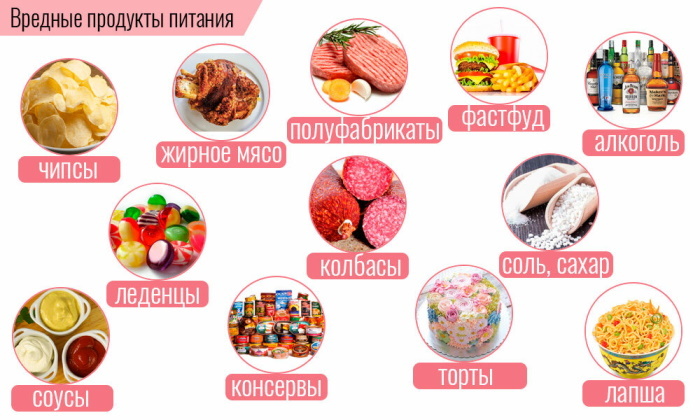
You need to give up:
- dairy products with high fat content;
- cabbage;
- garlic, onions, green onions;
- sour, sweet and sour fruits;
- fatty fish and meat;
- ready-made marinades, sauces;
- fresh baked goods;
- sausages;
- canned meat, vegetables, fish;
- smoked meats.
Products included in the permitted list can be baked, boiled or stewed in their own juice. Frying and deep-frying must be discarded. In case of diseases of the digestive tract, it is strictly forbidden to consume coffee, black tea, carbonated and alcoholic beverages. Preference is given to low-fat kefir and yogurt.
In case of ulcerative lesions of the stomach, antibacterial drugs should be included in the drug therapy. Patients are most often prescribed Metronidazole, Amoxicillin, Clarithromycin. With gastritis with high acidity, you need to take anticholinergics, antisecretory medicines and antacids.
Surgery
Surgical intervention is indicated for patients with stomach cancer and ulcerative lesions of the digestive tract. The operation is prescribed if the wounds on the surface of the mucous membrane do not heal for a long time. Surgical treatment is required for perforation, stenosis and malignancy.
Cancer patients undergo resection. The operation takes place in several stages. First, the surgeon dissects the ligaments, ligates the vessels and removes any of the gastric sections. After the performed manipulations, he sutures the stomach and connects it to the intestines. In case of carcinoma, an operation is also prescribed. The procedure takes several hours. To speed up the healing process, it is necessary to follow medical instructions during the rehabilitation period.
Pain in the epigastric region, radiating to the back, may indicate the development of a number of serious life-threatening diseases. The appearance of nausea, heartburn, bitterness in the mouth immediately after a meal is a reason to immediately contact the nearest medical facility. It is strictly forbidden to self-medicate.
Videos about epigastric pain
Malysheva on the possible causes of pain in the stomach:


